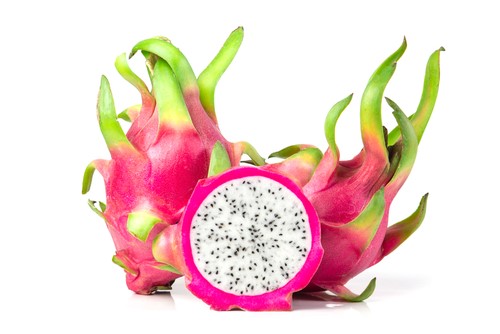Do you like to try new and unusual foods? Then dragon fruit is for you!
 Dragon fruit is also known as pitaya or the strawberry pear. If you have ever gone to the market, you’ve likely seen an exotic-looking, hot pink fruit that may have aroused your curiosity. From the outside, the fruit looks like a hot pink bulb ringed with curly greenish petals or scales – sort of like an artichoke.
Dragon fruit is also known as pitaya or the strawberry pear. If you have ever gone to the market, you’ve likely seen an exotic-looking, hot pink fruit that may have aroused your curiosity. From the outside, the fruit looks like a hot pink bulb ringed with curly greenish petals or scales – sort of like an artichoke.
So Unique
The dragon fruit is unlike any other fruit, in appearance or taste. It is produced by a fruit-bearing species of cacti that is native to Central and South America. It is now grown in tropical regions all over the world. Although it is the fruit of a cactus, it does not have any spines or needles on the outer skin.
Here’s a fun interesting fact I found: It lives only one night! First, a climbing cactus produces a beautiful pink or yellow flower. Called “moonflower” or “Queen of the night,” the plant blooms from evening to midnight, and then withers in strong sunlight. During the night, the pungent flowers are pollinated by moths and bats. The flower dies, but the cactus bears fruit about six times every year.
Varieties
The two most common types have bright, red skin with green scales that resemble a dragon – hence the name. The variety that is most widely available has white pulp speckled with tiny black seeds. The less common variety has red pulp with black seeds. Another variety has yellow skin and white pulp with black seeds. It is referred to as yellow dragon fruit. Aside from their different looks, different varieties of pitaya have subtle variations of flavor.
Nutrition
A 100-gram serving or 3 ounces of dragon fruit contains just 60 calories, about 18 calories from fat (all unsaturated), 8 calories from protein, and 34 calories from carbohydrate. Dragon fruit contains no cholesterol, saturated, or trans fat. Each serving also provides about 25 milligrams of vitamin C or 10% of the Daily Value (DV), along with 8 grams of calcium, and about 20 milligrams of phosphorus.
Flavor
The taste does not pack a big punch like it looks. If eaten before they are ripe, they taste bland and a bit sour. Once ripe, they taste ever so slightly sweet and syrupy. Many people describe the taste as a cross between a kiwi, a pear, and a watermelon. The flavor is very mild with a slight earthy flavor. The texture of dragon fruit is often compared to kiwifruit.
Selecting Dragon Fruits
If you are curious about trying dragon fruit, you are going to want to know how to choose them. To choose a ripe dragon fruit, look for a vivid pink, even-colored skin. A few blemishes on the skin are normal, but if the fruit has many blotches, it may be over-ripe. Avoid fruit that has dark blotches or bruises, brown dry spots, or dry spines.
Hold the dragon fruit in your palm and try pressing the skin with your thumb or fingers. It should give a little, but should not be too soft or mushy. If it is very firm, it will need to ripen for a few days.
Ripe dragon fruit can sit on the counter for a few days. To store it longer, place the fruit in a sealed plastic bag and store it in the refrigerator. The bag will prevent it from picking up the flavors and odors of other foods.
So Easy
Although it may look somewhat intimidating, dragon fruit is very easy to eat. Before cutting, wash the fruits thoroughly under running water. Place it on a cutting board and make two halves by cutting straight down or longitudinally with a sharp knife. By the way, the skin is not edible. Option one is to use a spoon to eat the fruit out of the skin. Option 2 is to remove the fruit’s flesh similar to an avocado. Scoop out the flesh with a spoon. Run a spoon along the edges of the skin and then scoop underneath to loosen the flesh. If the fruit is ripe, it should separate easily from the skin. Option three is to peel the skin off and slice the fruit into small pieces.
Finally, use the hollowed-out skin to make a decorative bowl for serving a fruit salad or dragon fruit ice cream.
Once you’re familiar with the basic fruit itself, you may be wondering what else you can do with it. Here are several great ideas for serving dragon fruit:
• Simply slice it up and eat it
• Chop it into small pieces, top with Greek yogurt, and chopped nuts
• Include it in a fruit salad
• Add it to a smoothie
• Toss it into fruit salsa
Once you learn to love the taste of dragon fruit, you will think of many more ways to enjoy it. You can substitute dragon fruit anywhere you see kiwi in recipes. Have fun and see what it can do with some of your favorite recipes.
Be sure to pick up this unique, delicious fruit if you see it on your next shopping trip!! It has a distinguished flavor and texture, which makes eating healthy easier.
Written by Vicki Hayman, MS, University of Wyoming Extension Nutrition and Food Safety Educator
Sources: